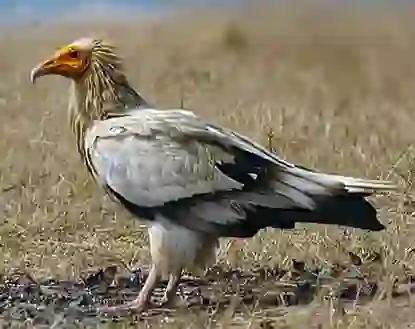
Egyptian Vulture
Egyptian Vulture
Egyptian Vulture
The Egyptian vulture, a small vulture with a wide distribution across Africa, southern Europe, and southern Asia. Known as the 'Pharaoh's chicken', they were revered as sacred birds in ancient Egypt. Let's explore the fascinating ecology of the Egyptian vulture and the threats they face today.
Egyptian Vulture Basic Infomation

| Property | Value |
|---|---|
| Scientific Name | Neophron percnopterus |
| Taxonomic Status | SPECIES |
| Rank | SPECIES |
| Vernacular Names | Egyptian Vulture |
| Kingdom | Animalia |
| Phylum | Chordata |
| Class | Aves |
| Order | Accipitriformes |
| Family | Accipitridae |
| Genus | Neophron |
| Habitats | Africa, southern Europe, and South Asia |
| Conservation Status | Endangered (EN) |

Size
They are about 22 to 28 inches (55 to 70 centimeters) in length, with a wingspan of about 59 to 67 inches (150 to 170 centimeters). They weigh about 3.3 to 4.9 pounds (1.5 to 2.2 kilograms). Females are larger than males.

Lifespan
Their lifespan in the wild is estimated to be about 20 years.

Distribution
They are widely distributed in Africa, southern Europe, and southern Asia. They prefer open areas and are found in savannas, grasslands, and rocky areas. They migrate to warmer regions during the winter.
Egyptian Vulture Q&A

What kind of vulture is the Egyptian vulture?
The Egyptian vulture is a bird of prey belonging to the family Accipitridae and the genus Neophron.
They are smaller than other vultures and have a distinctive yellow face. They also have a wedge-shaped tail. They are widely distributed in Africa, southern Europe, and southern Asia, preferring open areas like savannas, grasslands, and rocky areas. They play an important role in nature as scavengers, feeding on the carcasses of dead animals. They use their sharp beaks to tear flesh from carcasses and can also crush bones. In addition to animal carcasses, they also eat bird eggs, insects, and reptiles. They are also known to scavenge on food scraps and garbage left by humans. They are quite adaptable in their diet. They can be solitary but often travel in flocks of a few to several dozen individuals. They build their nests on cliffs or rocky ledges. The nests are made from branches, leaves, and other materials, and the female usually lays 1 to 2 eggs. The eggs hatch after about 42 days, and the chicks fledge after about three months. Both parents participate in raising their young.

What do Egyptian vultures eat?
Egyptian vultures primarily feed on carrion, meaning the carcasses of dead animals, and rarely attack live animals.
They use their sharp beaks to tear through the skin and flesh of carcasses. They can also crush bones. They eat a variety of things in addition to animal carcasses, including bird eggs, insects, and reptiles. They may also eat food scraps and garbage left by humans. They are very adaptable when it comes to food.

[Quiz!] Is it true that Egyptian vultures use tools?
Yes, it's true! Egyptian vultures are one of the few animals known to use tools.
They use stones to crack open ostrich eggs. Ostrich eggs are very hard and cannot be broken open with their beak alone. To crack the eggs, they pick up a stone with their beak and throw it at the ostrich egg. Once the egg cracks, they use their beak to widen the crack and eat the contents. Using stones as tools is a testament to their intelligence.

[Quiz!] Were Egyptian vultures sacred birds in ancient Egypt?
Yes, Egyptian vultures were revered as sacred birds in ancient Egypt.
They were believed to be the incarnation of the 'Mother Goddess,' Nekhbet, the goddess of childbirth and protector of mothers and children. Egyptian vultures were also called the 'eyes of Ra,' the Sun God. This is because they soar high in the sky, believed to be closest to the sun. They were also known as 'Pharaoh's chickens' because their white head and body resembled a pharaoh wearing a white crown. Ancient Egyptians held Egyptian vultures in high regard and forbade killing them. Those who harmed them faced severe punishment. They would even mummify and bury Egyptian vultures.

[Quiz!] Are Egyptian vultures endangered?
The Egyptian vulture is listed as 'Endangered' (EN) on the IUCN (International Union for Conservation of Nature) Red List.
Their population is declining in recent years, mainly due to human activities:
・Habitat loss: Agricultural development, conversion of land to pasture, and urbanization are leading to the loss of their habitat.
・Poaching: They are targeted by poachers for their feathers, talons, and beaks, which are highly valued in the illegal wildlife trade.
・Poisoning: They can be poisoned by consuming pesticides and poisoned bait.
・Collisions with power lines: They are often killed by collisions with power lines.
To protect Egyptian vultures, it is crucial to protect their habitat, prevent poaching, regulate the use of poisons, and mitigate collisions with power lines. We must also be aware of the current situation of Egyptian vultures and consider what actions we can take to protect them.

Would you like to become a part of the 'Animalbook.jp'?
Turn your knowledge into Q&A and share it with the world. ※Publication will be activated after purchase. Let's share information together!
Egyptian Vulture Type of List

Efforts to Protect Egyptian Vultures
- Establishment of protected areas
- Strengthening law enforcement against poaching
- Regulation of the use of poisons
- Mitigating collisions with power lines
- Public awareness campaigns
- Captive breeding and reintroduction programs
Information
Congratulations! You are the first commenter!

Create Your Favorite List!
Egyptian Vulture
Save the animals you love! Build your own list to quickly revisit your favorites later.

Would you like to leave a comment?
※Please note: This is for the purchase of rights to post comments within the article.
Find Your Favorites!
Our shop offers a unique and attractive selection of goods themed around various animals.
Egyptian Vulture References
Egyptian Vulture Introduction of media used

Kousik Nandy, CC BY-SA 3.0, via Wikimedia Commons

Help Enrich Our Animalbook.jp with Your Media!
We are constantly looking to expand and enrich our Animalbook.jp with amazing photos and videos of animals. If you have any media that you'd like to share, please contribute and help us showcase the beauty and diversity of the animal kingdom. Your submissions will be credited and featured in our encyclopedia, reaching a wide audience of animal lovers.


















